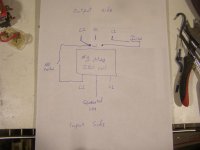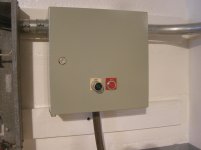dalmatiangirl61
Diamond
- Joined
- Jan 31, 2011
- Location
- BFE Nevada/San Marcos Tx
I'm down to the finishing touches for getting my rpc connected and have a few questions, second pic is how I think start/stop switches should be wired, just need confirmation that is correct, or told how to change it. 3rd pic is the switches, are these suitable to wire in as drawn in pic 2, or should I use these to control a smaller contactor or relays?? No amp rating on the switches, and not sure amperage draw on coil, I think these switches will be fine, need confirmation.
I have an ICM450 voltage monitor to install, the manual assumes you have 3ph and indicates wiring going to both sides of contactor, manual also shows load side connections as optional. It would seem to me that if I wired line and load side of ICM, when contactor is open (rpc off), it would show a fault as it is only getting L1 & L2. So I'm thinking it would be best to just wire line side to output side of mag contactor, and skip load side connections. Any thoughts?
I've been getting by for past few years running an extension cord from rpc to machines, just 1 cord, its a pia. The goal of getting rpc wired into a breaker box is so that at some point everything is in conduit, but that is still a year, maybe more, away. So a thought that occurred to me is to put a female plug on the back of each machine so they can be daisy chained together. Run extension cord to first lathe, plug second lathe into first, 3rd into second, etc. This is a 1 person shop, rarely have 2 machines running, rpc can handle up to 60 combined hp. I'm sure its not code, but I think it would work fine. Thoughts?
I have an ICM450 voltage monitor to install, the manual assumes you have 3ph and indicates wiring going to both sides of contactor, manual also shows load side connections as optional. It would seem to me that if I wired line and load side of ICM, when contactor is open (rpc off), it would show a fault as it is only getting L1 & L2. So I'm thinking it would be best to just wire line side to output side of mag contactor, and skip load side connections. Any thoughts?
I've been getting by for past few years running an extension cord from rpc to machines, just 1 cord, its a pia. The goal of getting rpc wired into a breaker box is so that at some point everything is in conduit, but that is still a year, maybe more, away. So a thought that occurred to me is to put a female plug on the back of each machine so they can be daisy chained together. Run extension cord to first lathe, plug second lathe into first, 3rd into second, etc. This is a 1 person shop, rarely have 2 machines running, rpc can handle up to 60 combined hp. I'm sure its not code, but I think it would work fine. Thoughts?









